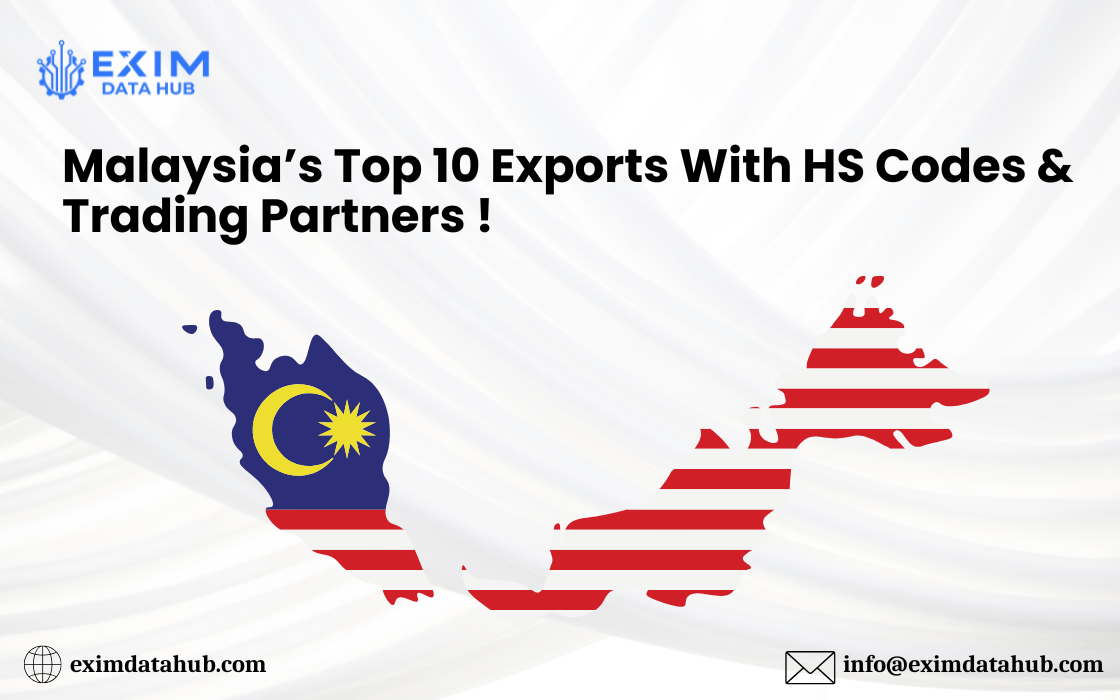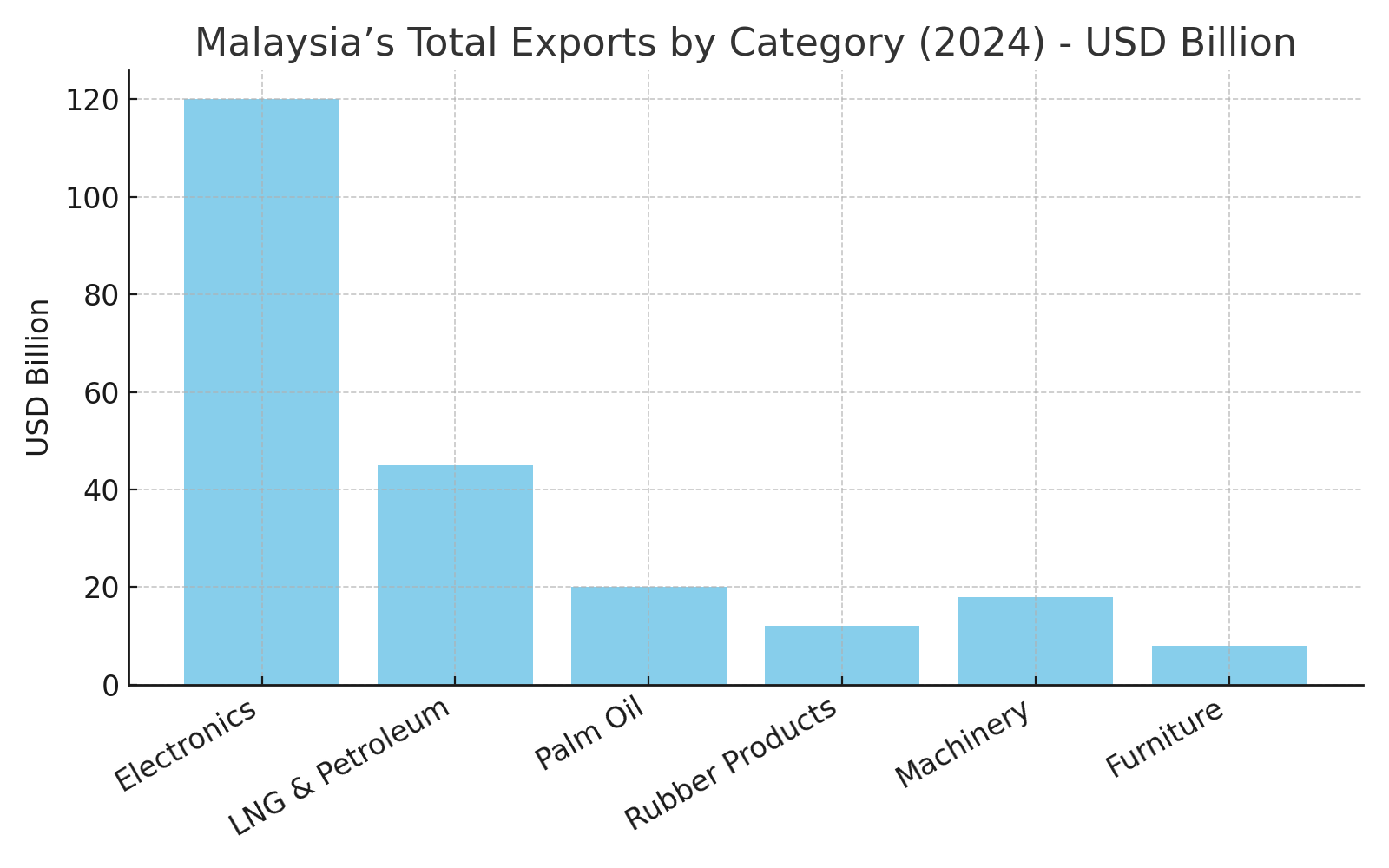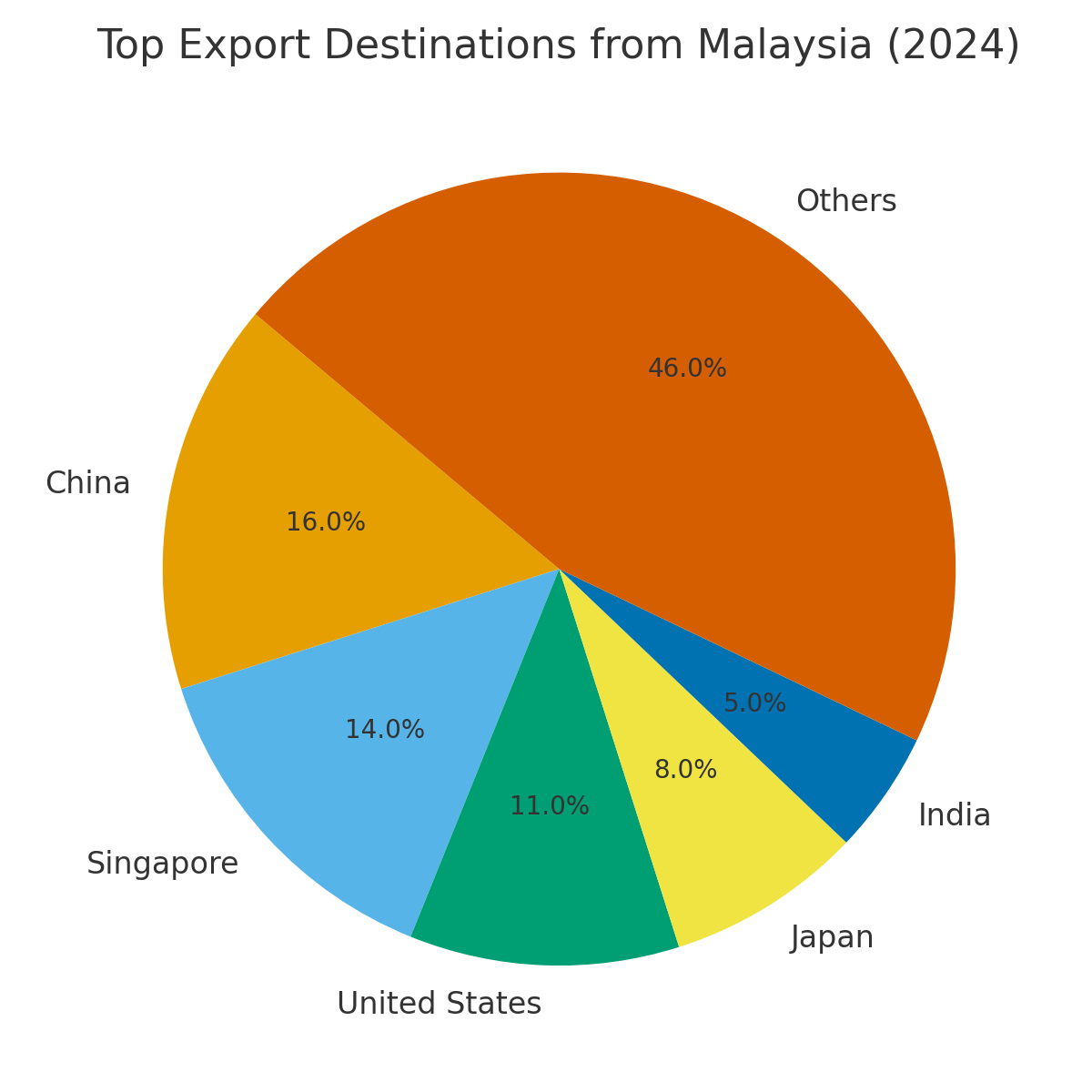
Explore the latest trends, market data, and export insights for Malaysia’s shipments to the world. This guide highlights trade opportunities, key export categories, trading partners, and essential HS code information to help businesses make informed export decisions.
🔹 Introduction
Malaysia has built a diverse export economy spanning electronics, palm-based products, petroleum, and industrial machinery. In 2024 its total exports reached USD 290 billion, showing steady demand from Asia, the US, and Europe. Electronics, refined petroleum, liquefied natural gas, and palm oil remain pillars of Malaysian trade, while manufactured goods and high-value food products are gaining traction.
For exporters and supply-chain planners, understanding what drives Malaysia’s exports and where they go is critical. This article breaks down Malaysia’s top export categories, market trends, HS codes, and how tools like Exim Data Hub can simplify your next shipment.
🔹 What Are Malaysia’s Top Exports?
➤ Electronics & Electrical Equipment – Integrated circuits, semiconductors, and consumer electronics assembled in Malaysia for global markets.
➤ Liquefied Natural Gas & Petroleum Products – Refined fuels and LNG shipped to Asian and European buyers.
➤ Palm Oil & Palm-Based Products – Edible oils, oleochemicals, and biodiesel ingredients exported worldwide.
➤ Machinery & Mechanical Parts – Industrial equipment and machine components.
➤ Rubber & Rubber Articles – Medical gloves, tires, and semi-processed rubber.
➤ Chemicals & Fertilizers – Inputs for agriculture and manufacturing.
➤ Metal Products – Aluminium, tin, and steel products.
➤ Processed Food & Beverages – Cocoa, canned seafood, sauces, and packaged snacks.
➤ Furniture & Wood Products – Wooden furniture and plywood, mainly to the US and Japan.
➤ Textiles & Apparel – Niche segments such as uniforms and specialty fabrics.
These exports show Malaysia’s strength in both high-tech manufacturing and resource-based products.
🔹 Key Market Trends in Malaysia
| Market Driver | Description |
|---|---|
| ➤ Supply-Chain Diversification | Relocation of electronics assembly and testing to Malaysia boosts export volumes. |
| ➤ Sustainability Shift | Rising demand for certified sustainable palm oil and eco-friendly rubber products. |
| ➤ Trade Agreements | RCEP and ASEAN FTAs reduce tariffs and speed up customs clearance. |

In 2024, electronics and electrical equipment exceeded USD 120 billion, LNG and refined petroleum contributed nearly USD 45 billion, while palm oil products surpassed USD 20 billion. Processed food and furniture showed steady gains, especially in the EU and Middle East.

The last quarter of 2024 saw increased electronics shipments to the US and China and higher palm oil exports to India and the Middle East. This diversification helps Malaysia buffer against demand shocks.
🔹 Top Export Destinations of Malaysia
Destination | Approx Share of Exports
➤ China | ~16%
➤ Singapore | ~14%
➤ United States | ~11%
➤ Japan | ~8%
➤ India | ~5%
➤ China and Singapore import a mix of electronics and petroleum products.
➤ The US and Japan buy high-value electronics, rubber products, and furniture.
➤ India leads in palm oil and agricultural imports.
🔹 Opportunities for Exporters
➤ Supply certified palm oil, eco-rubber, or halal-certified food to achieve premium pricing.
➤ Partner with electronics companies relocating testing and assembly to Malaysia.
➤ Develop finished furniture and branded food items for the US, Japan, and EU markets.
➤ Explore digital B2B platforms to reach niche buyers quickly.
➤ Use Exim Data Hub for verified buyer lists and HS classification support.
🔹 HS Codes for Malaysia’s Key Export Lines
Here are sample HS codes for top Malaysian exports:
➤ 85423100 – Electronic integrated circuits (processors/controllers)
➤ 15119090 – Palm oil and its fractions
➤ 40151100 – Rubber medical gloves
➤ 27111100 – Liquefied natural gas
➤ 94036000 – Wooden furniture
🔹 How Exim Data Hub Helps Exporters
| Feature | Exporter Benefit |
|---|---|
| ➤ HS Code Intelligence | Classify goods accurately and avoid delays. |
| ➤ Buyer/Seller Insights | Access verified importers in your target markets. |
| ➤ Forecast Reports | Plan shipments based on demand cycles and price trends. |
| ➤ Compliance Tools | Stay updated on documentary and tariff requirements. |
Whether you’re a first-time exporter or managing a large logistics team, Exim Data Hub gives you the tools to track demand, discover buyers, and ensure compliance across 100+ markets. You can also explore verified international trade statistics and partner data through the World Integrated Trade Solution (WITS).
🔹 Conclusion
➤ Malaysia’s export profile blends high-tech manufacturing with resource-based strength.
➤ Knowing top products, HS codes, and destinations helps exporters plan smarter and reduce risks.
➤ Differentiation, certifications, and data-driven planning unlock higher-margin opportunities.
Want to export smarter? Use Exim Data Hub to stay ahead in global trade and tap into verified buyers worldwide.
🔹 Frequently Asked Questions (FAQ)
Q1: Is certification required for exporting palm oil, electronics or furniture from Malaysia?
Yes. Many markets require ISO, HACCP, or sustainability certifications depending on the product.
Q2: How large is the market for Malaysia’s electronics exports?
Electronics are Malaysia’s largest export category, accounting for over a third of total shipments in 2024.
Q3: What are the fastest-growing export segments in 2025?
Advanced electronics, certified palm-based products, and branded processed food are expected to lead.







